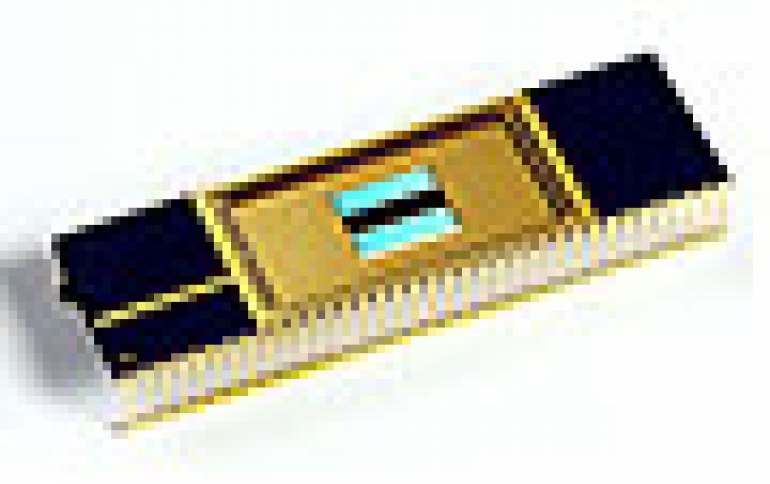
Samsung And Numonyx Join Forces On Phase Change Memory
Samsung and Numonyx B.V. today announced they are jointly developing market specifications for Phase Change Memory (PCM) products, a next generation memory technology for handsets, embedded systems and high-end computing devices.
The companies anticipate that creating common hardware and software compatibility for PCM products should help simplify designs and shorten development time.
Phase change memory produces very fast read and write speeds at lower power than conventional NOR and NAND flash memory, and allows for bit alterability normally seen in RAM.
"Our joint efforts with Numonyx will enable a more secure path for introducing PCM into the mobile environment," said SeiJin Kim, vice president, mobile memory technology planning and enabling, Samsung Electronics. "We anticipate that PCM will eventually be a major addition to our family of memory products, one that will nicely compliment our other mobile memory solutions and ultimately increase our leadership in the industry," he added.
"The collaboration between two memory industry leaders, Numonyx and Samsung, is helping to provide the kind of direction and clarity that is often needed when new technologies are introduced. The common specifications will enable chipset vendors and others in the ecosystem to standardize and more easily support the delivery of a new generation of memory technology that will benefit not only handset OEMs, but also manufacturers of embedded systems and high-end computing devices, and their customers."
Samsung and Numonyx are developing common specifications ? or "pin for pin" hardware and software compatibility ? for mobile, embedded and other potential computing applications supporting the JEDEC LPDDR2 Low Power Memory Device Standard. The LPDDR2 standard offers advanced power management features, a shared interface for nonvolatile memory (NVM) and volatile memory (SDRAM), and a range of densities and speeds.
Phase change memory has many of the advantages of NAND and NOR flash memory as well as other RAM memories ? allowing data to be read at RAM speeds while lowering the cost and power consumption levels by reducing the large amounts of RAM often used in today?s digital applications.
Phase change memory will also be "executable", allowing a separation of code and data for reliable code storage?particularly useful in handsets with higher data content. PCM devices will have faster programming ability than other types of memory as its RAM-like features will enable programming changes to be made bit by bit, instead of having to erase entire blocks of information.
Common specifications between the two companies will be completed this year, with both companies expecting to have compliant devices available next year.
Phase change memory produces very fast read and write speeds at lower power than conventional NOR and NAND flash memory, and allows for bit alterability normally seen in RAM.
"Our joint efforts with Numonyx will enable a more secure path for introducing PCM into the mobile environment," said SeiJin Kim, vice president, mobile memory technology planning and enabling, Samsung Electronics. "We anticipate that PCM will eventually be a major addition to our family of memory products, one that will nicely compliment our other mobile memory solutions and ultimately increase our leadership in the industry," he added.
"The collaboration between two memory industry leaders, Numonyx and Samsung, is helping to provide the kind of direction and clarity that is often needed when new technologies are introduced. The common specifications will enable chipset vendors and others in the ecosystem to standardize and more easily support the delivery of a new generation of memory technology that will benefit not only handset OEMs, but also manufacturers of embedded systems and high-end computing devices, and their customers."
Samsung and Numonyx are developing common specifications ? or "pin for pin" hardware and software compatibility ? for mobile, embedded and other potential computing applications supporting the JEDEC LPDDR2 Low Power Memory Device Standard. The LPDDR2 standard offers advanced power management features, a shared interface for nonvolatile memory (NVM) and volatile memory (SDRAM), and a range of densities and speeds.
Phase change memory has many of the advantages of NAND and NOR flash memory as well as other RAM memories ? allowing data to be read at RAM speeds while lowering the cost and power consumption levels by reducing the large amounts of RAM often used in today?s digital applications.
Phase change memory will also be "executable", allowing a separation of code and data for reliable code storage?particularly useful in handsets with higher data content. PCM devices will have faster programming ability than other types of memory as its RAM-like features will enable programming changes to be made bit by bit, instead of having to erase entire blocks of information.
Common specifications between the two companies will be completed this year, with both companies expecting to have compliant devices available next year.





















